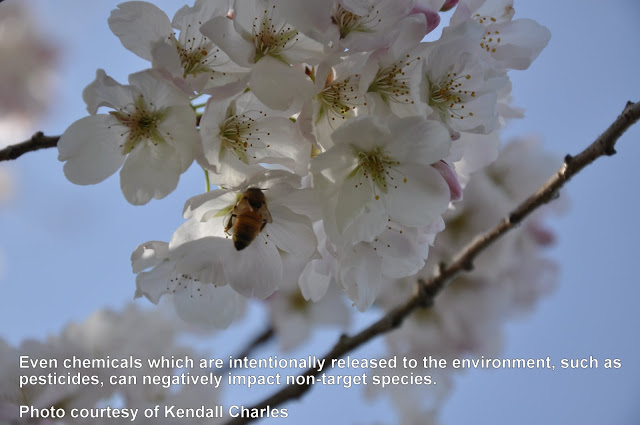A multitude of chemicals enter the Georgia Basin environment through a wide range of sources. While some, such as metals, are present naturally in the environment, others are man-made and are released during their manufacture, use, and disposal.
Many natural and man-made chemicals are potentially harmful to human and/or environmental health, depending on the conditions and level of exposure. Due to their potential to cause harm in the environment, we refer to these chemicals as environmental “contaminants”.

Man-made chemicals are produced because of specific properties that make them “beneficial” to humans. Some of these chemicals are released to the environment intentionally, while others are released inadvertently. For example, pesticides are chemicals whose beneficial property is their toxicity to nuisance species of plants, rodents, insects, and microorganisms. Other man-made chemicals are used as fertilizers and are intentionally added to soils to supply nutrients necessary for plant growth. Agricultural and forest industries, landscaping companies, golf courses, and householders intentionally apply pesticides and chemical-based fertilizers to select areas of our environment. These chemicals benefit humans by increasing the production of desirable plant species, such as crops and timber resources. The pesticides kill competing species of plants and insect pests, while the fertilizers increase the availability of soil nutrients for the rapid growth of desirable species. Unfortunately, these chemicals may also have detrimental impacts on non-target species.
Similarly, the medical community relies heavily on pharmaceutical chemicals, such as antibiotics and antimicrobials, to treat and prevent disease by killing pathogenic microorganisms. Other highly toxic chemicals are used as chemotherapy drugs to fight cancer. Unlike pesticides and fertilizers, pharmaceutical chemicals are not produced with intent to release them to the environment; however, their use and disposal results in their release to the environment in municipal wastewater treatment plant discharges and in landfill leachates. In addition, veterinary pharmaceuticals administered to pets and livestock enter the environment through fecal material which is carried to ditches and waterways through surface runoff and storm drains.
Many other chemicals are used in manufacturing to impart desirable properties such as flexibility, stability, or resistance to degradation in a wide range of manufactured products and goods which are designed to improve our quality of life. Clothing, cosmetics, cleaning products, electronics, furniture, automobiles, paper products, and many other items that we use on a daily basis contain chemicals which can eventually make their way into the environment. Some environmental contaminants (such as dioxins, furans and PAHs) are not produced intentionally, but are formed and released inadvertently, as by-products, during the production of other chemicals and products and also as a result of combustion.
Regardless of their method of entry to the environment, many of these chemical contaminants have the potential to adversely impact both ecosystem and human health. For many of the chemicals currently in use, the full range of potentially harmful effects, the conditions and exposure levels which could cause these effects, and the current exposure levels of sensitive species are not fully understood. In order to minimize risks to humans and the environment, it’s important to ensure that all chemicals in use are managed safely and that releases to the environment are well controlled.
More information on contaminant concerns:
